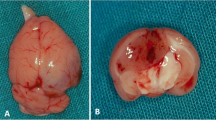Abstract
Brain tumour is an uncontrollable growth of abnormal cells in the brain that may lead to cancer. Tumours are detected and diagnosed by manually analyzing Magnetic Resonance Imaging (MRI) scans. It is a time and resource consuming process which leads to prolonged waiting times for brain tumour patients and adversely affect their life expectancy. Deep learning has been widely researched to automate this process. Previous studies conducted in this area have not systematically analyzed how different factors affect the accuracy rate of a Convolutional Neural Network (CNN). These factors include the size of the dataset, data augmentation and the number epochs used in a model. This paper addresses these issues by proposing a workflow that systematically analyses the contributing factors to a CNN’s accuracy. The results from the proposed methodology show that the size of the dataset and data augmentation are some of the important factors which affect the accuracy rates of a CNN model.
Access this chapter
Tax calculation will be finalised at checkout
Purchases are for personal use only
Similar content being viewed by others
References
Hossain, T., Shishir, F.S., Ashraf, M., Al Nasim, A., Shah, F.M.: Brain tumor detection using convolutional neural network. In: 1st International Conference on Advances in Science, Engineering and Robotics Technology, pp. 1–6. ICASERT (2019)
Brindha, P.G., Kavinraj, M., Manivasakam, P., Prasanth, P.: Brain tumor detection from MRI images using deep learning techniques. In: IOP Conference Series: Materials Science and Engineering (2021). https://doi.org/10.1088/1757-899x/1055/1/012115
Siar, M., Teshnehlab, M.: Brain tumor detection using deep neural network and machine learning algorithm. In: 9th International Conference on Computer and Knowledge Engineering, pp. 363–368. ICCKE (2019)
Yamashita, R., Nishio, M., Do, R.K.G., Togashi, K.: Convolutional neural networks: an overview and application in radiology. Insights Imaging 9(4), 611–629 (2018). https://doi.org/10.1007/s13244-018-0639-9
Brownlee, J.: Difference Between a Batch and an Epoch in a Neural Network. shorturl.at/desH0
Bushaev, V.: Adam—Latest Trends in Deep Learning Optimization. shorturl.at/wGOT8.
Ari, A., Hanbay, D.: Deep learning based brain tumor classification and detection system. Turk. J. Electr. Eng. Comput. Sci. 26, 2275–2286 (2018)
Cruz, J.A., Wishart, D.S.: Applications of machine learning in cancer prediction. Cancer Inf. 2, 59–77 (2006)
Nazir, M., Shakil, S., Khurshid, K.: Role of deep learning in brain tumour detection and classification. Comput. Med. Imaging Graph. 91, 101940 (2021)
Acknowledgements
The work presented in this paper is supported by EPSRC research grant EP/R043787/1.
Author information
Authors and Affiliations
Corresponding author
Editor information
Editors and Affiliations
Rights and permissions
Copyright information
© 2021 Springer Nature Switzerland AG
About this paper
Cite this paper
Ahmed, W., Konur, S. (2021). Detection of Brain Tumour Using Deep Learning. In: Bramer, M., Ellis, R. (eds) Artificial Intelligence XXXVIII. SGAI-AI 2021. Lecture Notes in Computer Science(), vol 13101. Springer, Cham. https://doi.org/10.1007/978-3-030-91100-3_10
Download citation
DOI: https://doi.org/10.1007/978-3-030-91100-3_10
Published:
Publisher Name: Springer, Cham
Print ISBN: 978-3-030-91099-0
Online ISBN: 978-3-030-91100-3
eBook Packages: Computer ScienceComputer Science (R0)




